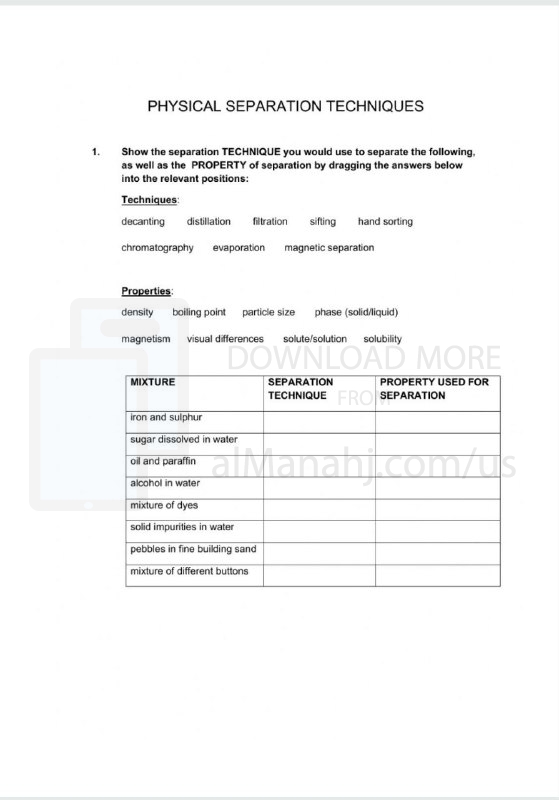| You are here: Almanahj Website ⇒ American curriculum ⇒ 10th Grade ⇒ Physics ⇒ Term 1 | ||
|---|---|---|
Worksheet about Physical Separation | ||
|---|---|---|
| Subject: Physics | ||
| 10th Grade | ||
| Term 1 | ||
| Year: 2023/2024 | ||
| Size: 569.4KB | ||
| Number of clicks: 81 | ||
| Publish date:November 03, 2023 | ||
| Added by: Eman | ||
| Last download date: 2024-08-22 06:16:27 | ||
| Updated by: Eman9966 on 2023-11-03 07:56:59 | By: theodor MrsKW | |
| File info: Info The "Physical Separation Worksheet for Grade 10" is a resource designed to introduce students to the various methods and techniques used for physical separation of mixtures. This worksheet aims to enhance students' understanding of the principles and applications of physical separation in chemistry. 1. Introduction to Physical Separation:The worksheet begins with an introduction to physical separation, explaining its significance in separating mixtures into their individual components. Students learn that physical separation methods are based on the differences in physical properties, such as size, density, solubility, and magnetism, among others.2. Filtration:The worksheet explores the process of filtration as a physical separation method. Students learn about the setup and operation of a filtration apparatus to separate solid particles from liquids or gases. They understand the principle that filtration relies on the use of a porous barrier (filter) that allows the passage of certain components while retaining others.3. Distillation:The worksheet focuses on the technique of distillation for separating mixtures based on differences in boiling points. Students learn about the setup and process of distillation, including heating, vaporization, and condensation. They understand that distillation is used to separate components with distinct boiling points, enabling the collection of the more volatile substance as vapor and subsequent condensation.4. Evaporation:The worksheet discusses the process of evaporation as a method for separating mixtures. Students learn that evaporation involves heating a mixture to vaporize the solvent, leaving behind the dissolved or suspended solute. They explore real-life examples of evaporation, such as the separation of salt from seawater or the extraction of salt from saltwater pools.5. Magnetic Separation:The worksheet introduces magnetic separation as a technique utilized for separating magnetic substances from non-magnetic ones. Students learn about the use of magnets to attract and separate ferromagnetic materials from a mixture. They explore applications of magnetic separation in industries such as mining and recycling.6. Chromatography:The worksheet discusses chromatography as a physical separation method based on differences in solubility and affinity. Students learn about the principles of chromatography, including the stationary phase and the mobile phase. They explore various types of chromatography, such as paper chromatography and thin-layer chromatography, and understand their applications in separating mixtures.7. Critical Thinking and Problem-Solving:The worksheet includes critical thinking exercises and problem-solving activities related to physical separation. Students are presented with scenarios or mixtures and are challenged to analyze and determine the appropriate physical separation method to separate the components effectively.The "Physical Separation Worksheet for Grade 10" provides students with a comprehensive understanding of the principles and techniques used in physical separation. By engaging with the activities, students develop their knowledge of filtration, distillation, evaporation, magnetic separation, and chromatography. They also enhance their critical thinking, problem-solving, and analytical skills through the exercises provided. | ||
| Downloading link Worksheet about Physical Separation |
|---|
|
1698998139.pdf
The file is being prepared for download
|
| File images |
|---|
 |